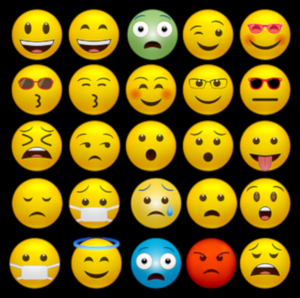
 New York, October 1 – Educational and communal institutions continue to struggle to reach and attract young people, but one such organization has hit on a novel way to engage the youth in the liturgical aspects of Jewish tradition: a prayer book that contains concise the visual imagery of online chat media to convey what the ancient, sometimes abstruse, text means.
New York, October 1 – Educational and communal institutions continue to struggle to reach and attract young people, but one such organization has hit on a novel way to engage the youth in the liturgical aspects of Jewish tradition: a prayer book that contains concise the visual imagery of online chat media to convey what the ancient, sometimes abstruse, text means.
The Modern Online Jewish Institute (MOJI) introduced its Emoji Siddur today, aimed at late Millennials and “Generation-Z” youth whose twenty-first-century upbringing has rendered them more comfortable in the language of online communication than of the traditional printed variety. The book contains the liturgical text on one page, while the facing page features the same text rendered in emoji so that today’s youth will find it more accessible and meaningful, a MOJI spokesman asserted in an interview.
“Each generation’s needs are different,” explained Rabbi Mendel Now. “Vernacular English was good enough for the last few editions of Jewish texts in America, but that’s not the case anymore. Today’s young Jews are more fluent in smileys, memes, and gifs than in the stodgy verbiage of the Birnbaum, Artscroll, Koren, or even Sim Shalom siddurim. With no disrespect to the august personages behind those volumes, we sensed the need to adapt our ancient prayers to a language more suitable for the emerging Jewish polity.”
The Emoji Siddur is available in both hard copies and downloadable as an app; the hard copy opens from top to bottom in the manner of a traditional checkbook or notepad, instead of the typical right-to-left orientation of a siddur. This configuration allows the user to “scroll” with his or her finger to the next page, in the manner that one does on a device. Rabbi Now called the innovation one of a series of “enhancements” the product offers.
“Obviously the hard copy edition can’t include animated gifs or emoji,” he noted. “Still, the app even includes visual instructions, such as a smiley covering its eyes right before the recitation of Sh’ma, and a figure taking three steps back, then forward, before the Amidah, as is customary. One of the advantages of the emoji format is that a single image can convey a set of complex ideas, whereas even in a concise language such as Hebrew the same idea might take several words or sentences to communicate.”
Rabbi Now also remarked that the emoji translation represents as much an advance as a return to the roots of human written communication, hieroglyphics.
We have lots of ideas, but we need more resources to be even more effective. Please donate today to help get the message out and to help defend Israel.

Leave a Reply